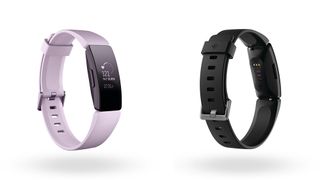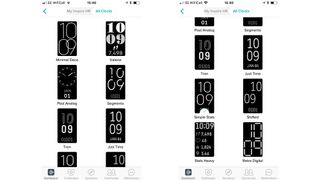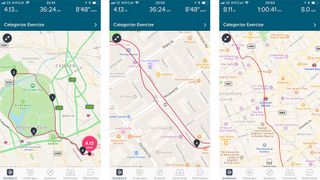You can trust Coach
I’ve tried a lot of Fitbits: the Alta HR, Charge 2, Ionic, Versa and Charge 3, and none of them have disappointed. In large part that’s down to the features they have in common – cardio fitness score, sleep tracking and insights, automatic exercise recognition – and the easy-to-use app. After spending a day wearing the Inspire HR, I feel like I’ve seen it all before, which is great because at £90 this device has a cheaper launch RRP than any of the Fitbit devices mentioned above.
If you're looking among the best fitness trackers to find the best Fitbit for you, you'll find that the Inspire HR and its even cheaper sibling, the Inspire (£70), are the entry-level options in the new Fitbit line-up, replacing the One (a pedometer with a clip), Flex 2 (a bracelet without a screen), and Alta and Alta HR (the Inspire forebears).
I wouldn’t take a second look at the basic Inspire, however, unless you’re really just after a wrist-worn step counter. For an extra £20 the Inspire HR gives you swim tracking (although the lack of an altimeter means it won’t count laps for you), connected GPS so the device can connect to your phone when you’re running and cycling to show your pace and plot your route on a map, and a heart rate monitor which grants you access to three notable features.

The first is the cardio fitness score, an estimate of your VO2 max. Most trackers have this now, but Fitbit adds something unique by comparing you with people of your gender and age group and, where needed, giving you advice on how to improve your score.
Fitbit applies the same trick to the second feature that sets Fitbit apart – sleep tracking. Your slumber is broken down into awake, REM, light and deep sleep, then you’ll see how that night stacks up against your 30-day average and the typical range for people in your demographic. It makes clear when the amount and quality of sleep you’re getting is a cause for concern.
The final extra unlocked by the heart rate monitor is female health tracking. Not something I’ve tried, but certainly something that sets Fitbit apart.
It’s a compelling offering and something that feels slickly executed when you get your hands on it. The body of the device is petite at just 16.2mm wide, 37mm long and 12.6mm deep. That last measurement sounds a bit chunky but the back is curved so it sits comfortably on the wrist, and at a featherlight 28g I barely noticed it was there.
Currently, the Inspire HR comes with a black, lilac or white band (with both small and large bands included in the box so you don’t have to worry about buying the wrong size). The band is made from silicone which helps it stay put during exercise and it looks pretty good, although if you’re not a fan there are several other accessories available – bands in stainless steel mesh (£59.99), prints (£24.99), leather (£34.99) and – a new look for Fitbit – a leather double wrap (£34.99). I haven’t seen these in flesh so can’t say if they’re as smart in person as they are on screen, but I did change the strap and it was an easy sprung bolt affair, so if you buy an alternative band you certainly won’t find you’re put off using it by a fiddly swap process.
The Inspire HR’s touchscreen is responsive and one of the major upgrades from the Alta HR, which you operated by tapping the bottom of the device. There’s also one button on the left-hand side which operates as a back button in the menus and a pause and stop button during manually tracked activities.
Flick up to scroll down through your day’s stats, steps, current heart rate, total calories burned, active minutes, distance travelled and how far you are towards the goal of 250 steps an hour. Scroll up to choose an exercise you want to manually track, follow a two- or five-minute breathing exercise, set an alarm or a timer, or find the limited settings menu to turn GPS and the heart rate monitor on or off. Swiping left or right or tapping the home screen cycles through the smaller secondary stat on display: date, steps, heart rate, distance travelled, calories burned, and active minutes. There are also ten styles of watch face to choose from in the Fitbit app.

So far I’ve taken the Inspire HR on one run, tracked one bike ride and tested the automatic tracking with another bike ride.
The first run wasn’t as smooth sailing as I had hoped. It didn’t take long for the Inspire HR to connect to my phone (you’re required to open the Fitbit app) but the GPS signal kept flicking in and out, with the device buzzing each time. It didn’t help that it was hard to read the screen in bright but overcast conditions in the middle of a March day. I finished with pace readings that made sense and a map that looked right (pictured, left), although it was way off once I zoomed in (pictured, middle).

To be fair, I was running in central London with my phone in a flipbelt by my stomach so I wasn’t really giving the device the chance to shine. It’ll need more testing, but even if these problems continue, it’s to be expected at this price point, and for the casual runner it’s serviceable enough. The good news is that the connected GPS was much better on the bike ride I tracked (pictured, right), and later in the day the screen was much easier to read as well.
The automatic tracking worked well, nailing the right amount of time for my cycle commute and correctly identifying the bike ride. It even identified a “sport” session on Sunday morning which I believe was a loaded carry – the items carried being 35kg of children.
I’ll continue testing the Inspire HR, but I’m confident my opinion on it won’t change. It covers all the basics for a casual exerciser and it covers them well. So well, in fact, I question who would need to pay the £40 to upgrade to the next Fitbit, the Charge 3. That extra cash will get you a larger screen, and a device that can track the floors you’ve climbed and lengths you’ve swum, set and send quick message replies if you’re on Android, and Fitbit Pay if you get the special editions (another £30). Considering the combination of its features and the price, the Inspire HR looks hard to better.
Buy Inspire HR from Fitbit | £89.99

Jonathan Shannon has been the editor of the Coach website since 2016, developing a wide-ranging experience of health and fitness. Jonathan took up running while editing Coach and has run a sub-40min 10K and 1hr 28min half marathon. His next ambition is to complete a marathon. He’s an advocate of cycling to work and is Coach’s e-bike reviewer, and not just because he lives up a bit of a hill. He also reviews fitness trackers and other workout gear.

